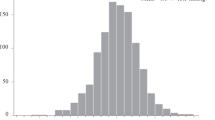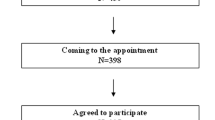Abstract
Patients with peripheral arterial disease (PAD) constitute a subgroup of high-risk hypertensives, but controlled studies on 24-h blood pressure (BP) and diurnal variation of BP are lacking. This study was performed in order to test the hypothesis that office BP (OBP) may underestimate 24-h BP in PAD patients in comparison to a matched control group. In all, 98 male patients (mean age 68 years) with a history of intermittent claudication and an ankle/brachial index less than 0.9, and 94 controls matched for age but without PAD or ischaemic heart disease performed 24-h recordings of ambulatory BP. A total of 59 patients had a history of hypertension and 69 were on treatment with BP-lowering drugs as compared to 17 and 23 of the control subjects, respectively. Office as well as 24-h systolic BP (SBP) were higher in patients as compared to controls (151±22 vs 140±20 mmHg, P<0.001 and 142±14 vs 133±15 mmHg, P<0.001, respectively), but did not differ with regard to diastolic BP. In an analysis of covariance with the continuous factors age, office SBP and the categorical factor antihypertensive treatment, 24-h SBP was higher in PAD patients compared to controls (P<0.05). The difference between office and night SBP was lower in PAD patients with antihypertensive treatment compared to controls (P=0.01). In conclusion, Male patients with PAD had higher systolic but not diastolic BP than age-matched control subjects. In PAD patients, 24-h SBP was higher than expected from OBP compared to controls. Night SBP was higher only in patients with antihypertensive treatment. In PAD patients, especially when on antihypertensive treatment, the severity of hypertension may be underestimated when based on OBP only.
This is a preview of subscription content, access via your institution
Access options
Subscribe to this journal
Receive 12 digital issues and online access to articles
$119.00 per year
only $9.92 per issue
Buy this article
- Purchase on SpringerLink
- Instant access to full article PDF
Prices may be subject to local taxes which are calculated during checkout




Similar content being viewed by others
References
Criqui MH et al. Mortality over a period of 10 years in patients with peripheral arterial disease. N Engl J Med 1992; 326: 381–386.
Smith GD, Shipley MJ, Rose G . Intermittent claudication, heart disease risk factors, and mortality. The Whitehall Study. Circulation. 1990; 82: 1925–1931.
SHEP Cooperative research group. Prevention of stroke by antihypertensive drug treatment in older persons with isolated Systolic hypertension. Final results of the Systolic Hypertension in the Elderly Program (SHEP). JAMA 1991; 265: 3255–3264.
Dahlof B et al. Morbidity and mortality in the Swedish Trial in Old Patients with hypertension (STOP-Hypertension). Lancet 1991; 338: 1281–1285.
Staessen JA et al. Randomised double-blind comparison of placebo and active treatment for older patients with isolated systolic hypertension. The Systolic Hypertension in Europe (Syst-Eur) trial investigators. Lancet 1997; 350: 757–764.
The Heart Outcomes Prevention Evaluation Study Investigators. Effects of an angiotensin-converting-enzyme inhibitor, ramipril, on cardiovascular events in high-risk patients. N Engl J Med 2000; 342: 145–153.
Sleight P et al. Blood-pressure reduction and cardiovascular risk in HOPE study. Lancet 2001; 358: 2130–2131.
Svensson P et al. Comparative effects of ramipril on ambulatory and office blood pressures: a HOPE substudy. Hypertension 2001; 38: E28–E32.
Verdecchia P . Prognostic value of ambulatory blood pressure: current evidence and clinical implications. Hypertension 2000; 35: 844–851.
Svensson P, Niklasson U, Ostergren J . Episodes of ST-segment depression is related to changes in ambulatory blood pressure and heart rate in intermittent claudication. J Internal Med 2001; 250: 398–405.
Rose G . The diagnosis of ischaemic heart pain and intermittent claudication in field surveys. Bull World Health Organ 1962; 27: 645–658.
O'Shea JC, Murphy MB . Ambulatory blood pressure monitoring: which arm? J Hum Hypertens 2000; 14: 227–230.
O'Brien E, Mee F, Atkins N, O’Malley K . Accuracy of the SpaceLabs 90207 determined by the British Hypertension Society protocol. J Hypertens 1991; 9: 573–574.
Mölgaard J . Intermittent claudication. Prevalence and risk factors. Academic Thesis. Linköping; 1997.
Janzon L, Bergentz SE, Ericsson BF, Lindell SE . Intermittent claudication and hypertension. Ankle pressure and walking distance in patients with well-treated and non-treated hypertension. Angiology 1981; 32: 175–179.
Gasowski J et al. Pulsatile blood pressure component as predictor of mortality in hypertension: a meta-analysis of clinical trial control groups. J Hypertens 2002; 20: 145–151.
Staessen JA et al. Risks of untreated and treated isolated systolic hypertension in the elderly: meta-analysis of outcome trials. Lancet 2000; 355: 865–872.
Verdecchia P et al. Ambulatory pulse pressure: a potent predictor of total cardiovascular risk in hypertension. Hypertension 1998; 32: 983–988.
Mancia G et al. Ambulatory blood pressure normality: results from the PAMELA study. J Hypertens 1995; 13: 1377–1390.
Verdecchia P et al. White coat hypertension and white coat effect. Similarities and differences. Am J Hypertens 1995; 8: 790–798.
Staessen J et al. Reference values for the ambulatory blood pressure and the blood pressure measured at home: a population study. J Hum Hypertens 1991; 5: 355–361.
MacMahon S et al. Blood pressure, stroke, and coronary heart disease. Part 1, Prolonged differences in blood pressure: prospective observational studies corrected for the regression dilution bias. Lancet 1990; 335: 765–774.
Staessen JA et al. Predicting cardiovascular risk using conventional vs ambulatory blood pressure in older patients with systolic hypertension. Systolic Hypertension in Europe Trial Investigators. JAMA 1999; 282: 539–546.
Zannad F, Matzinger A, Larche J . Through/peak ratios of once daily angiotensin converting enzyme inhibitors and calcium antagonists. Am J Hypertens 1996; 9: 633–643.
Verdecchia P et al. Altered circadian blood pressure profile and prognosis. Blood Press Monit 1997; 2: 347–352.
Ohkubo T et al. Prognostic significance of the nocturnal decline in blood pressure in individuals with and without high 24-h blood pressure: the Ohasama study. J Hypertens 2002; 20: 2183–2189.
Collins R et al. Blood pressure, stroke, and coronary heart disease. Part 2, Short-term reductions in blood pressure: overview of randomised drug trials in their epidemiological context. Lancet 1990; 335: 827–838.
Gueyffier F, Froment A, Gouton M . New meta-analysis of treatment trials of hypertension: improving the estimate of therapeutic benefit. J Hum Hypertens 1996; 10: 1–8.
Muller JE . Circadian variation in cardiovascular events. Am J Hypertens 1999; 12: 35S–42S.
Acknowledgements
We thank Anette Aly (RN), Linda Nilsson (BMA) and Eva Wallen (BMA) for skilful technical assistance, and Elisabeth Berg and Ulf Brodin for expert statistical advice. The study was supported by grants from the Swedish Heart–Lung Foundation, Karolinska Institutet and the Serafimer Hospital Foundation.
Author information
Authors and Affiliations
Corresponding author
Rights and permissions
About this article
Cite this article
Svensson, P., de Faire, U., Niklasson, U. et al. Office blood pressure underestimates ambulatory blood pressure in peripheral arterial disease in comparison to healthy controls. J Hum Hypertens 18, 193–200 (2004). https://doi.org/10.1038/sj.jhh.1001649
Received:
Revised:
Accepted:
Published:
Issue Date:
DOI: https://doi.org/10.1038/sj.jhh.1001649



